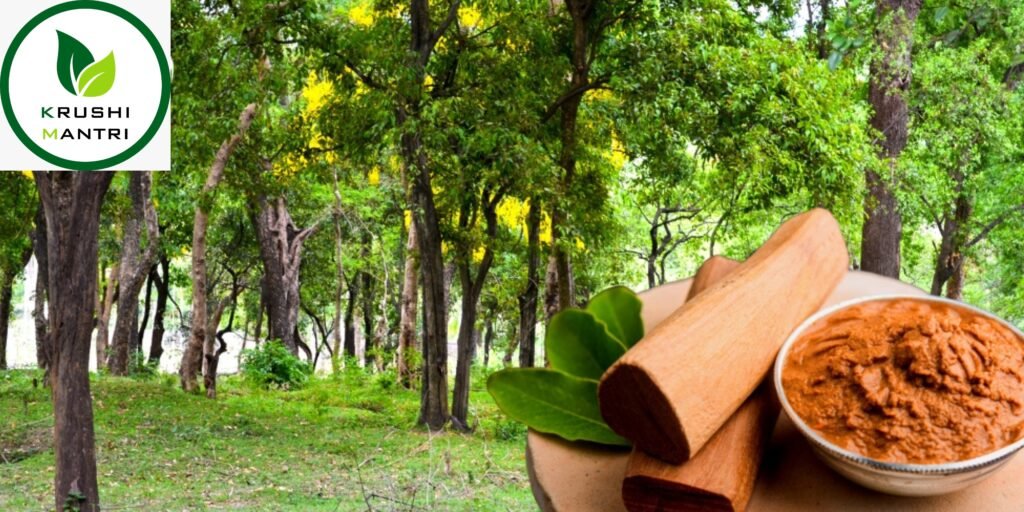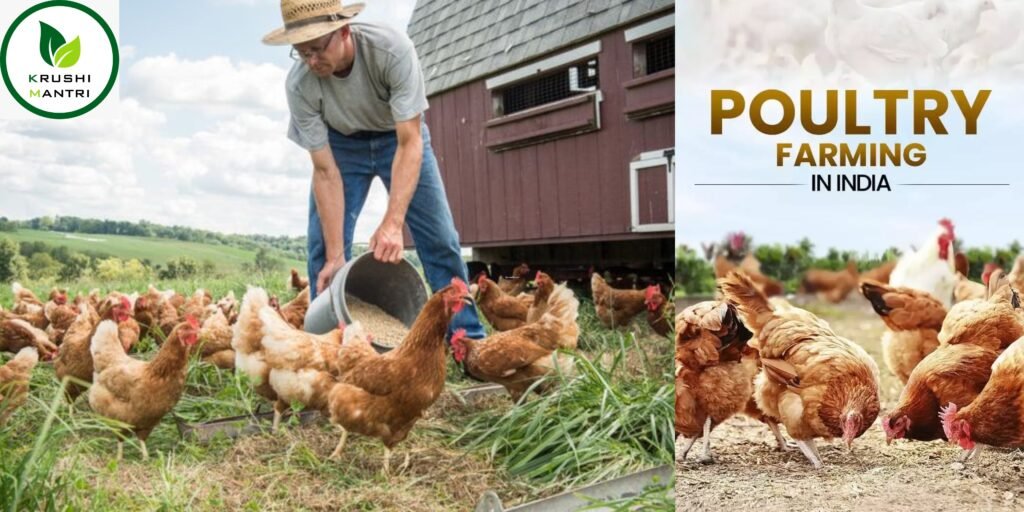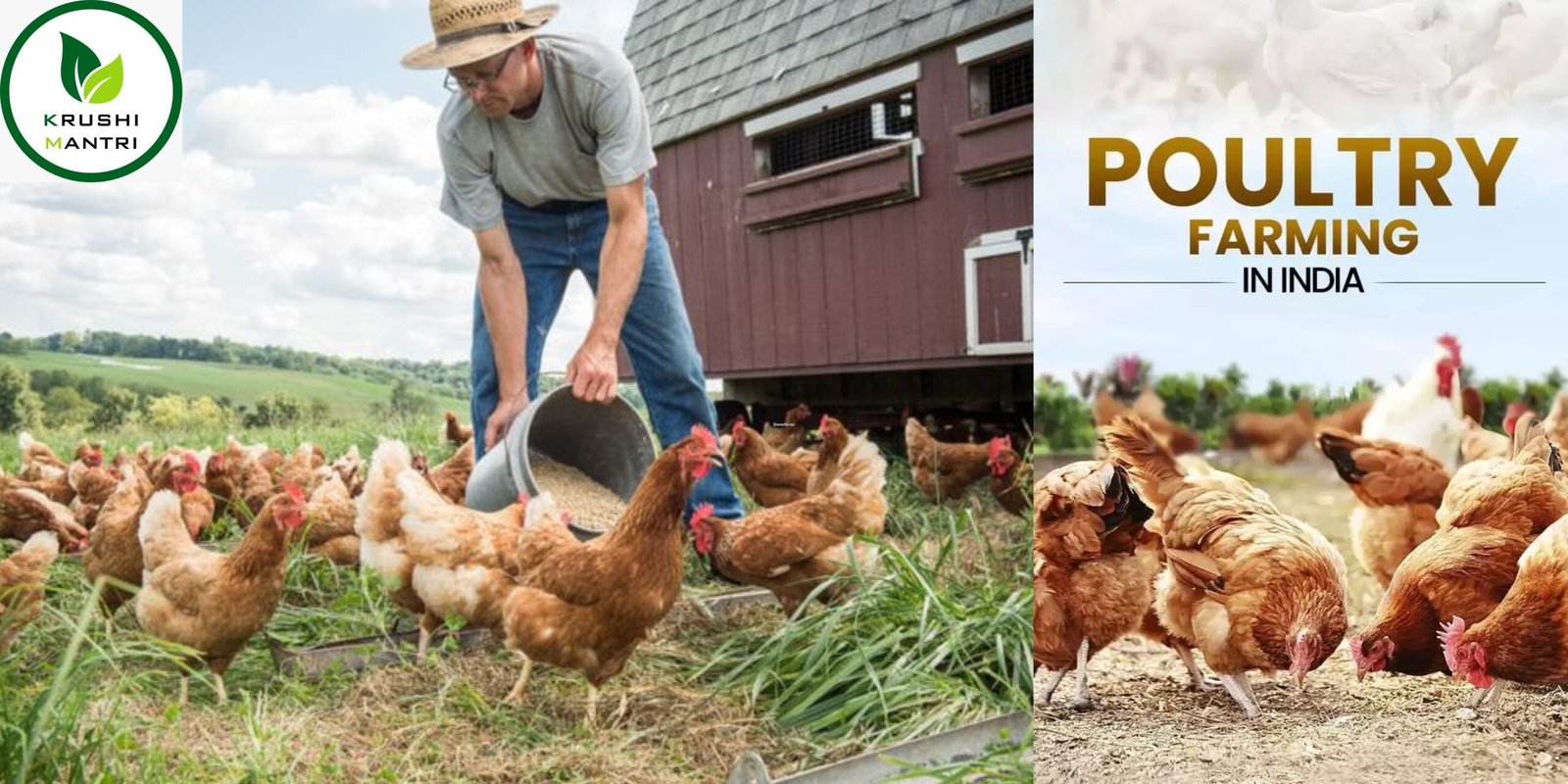Sandalwood tree farming has gained immense popularity in recent years due to its high profitability and increasing demand in both domestic and international markets. This blog provides an in-depth guide to sandalwood farming, focusing on red and white sandalwood, their prices, profitability, government schemes, farming steps, guidelines, and essential tips for farmers.
Introduction to Sandalwood Tree Farming
Sandalwood, often referred to as “green gold,” is a valuable tree with a wide range of applications, including perfumes, medicines, cosmetics, and religious rituals. Two primary types of sandalwood are cultivated: red sandalwood (Pterocarpus santalinus) and white sandalwood (Santalum album).
Types of Sandalwood
1. White Sandalwood (Santalum album)
White sandalwood, scientifically known as Santalum album, is one of the most valuable and sought-after tree species globally. It is cherished for its aromatic heartwood and essential oil, which have been used for centuries in various industries.
- Uses: White sandalwood has a wide range of applications:
- Aromatic Uses: The essential oil extracted from white sandalwood is a key ingredient in high-end perfumes, incense, and cosmetics. Its warm, woody fragrance is long-lasting and highly coveted.
- Medicinal Uses: In traditional Ayurvedic and Unani medicine, white sandalwood is used for its anti-inflammatory, antiseptic, and calming properties. It is often used to treat skin conditions, improve mental clarity, and as a natural coolant.
- Cultural and Religious Uses: In many cultures, the wood and paste of white sandalwood are used in religious rituals and ceremonies. It is also employed in crafting idols, prayer beads, and other religious artifacts.
- Growth Regions: White sandalwood thrives in tropical and subtropical climates and is predominantly grown in India. The key regions for its cultivation include:
- Karnataka: Known as the traditional hub of sandalwood farming, Karnataka has favorable climatic conditions and soil for the growth of white sandalwood. The state is also home to the famous Mysore sandalwood.
- Tamil Nadu: Another prominent region for white sandalwood farming, Tamil Nadu offers well-drained soils and moderate rainfall, which are ideal for the growth.
- Andhra Pradesh: With its semi-arid regions, Andhra Pradesh has emerged as a significant player in the cultivation of white sandalwood. The state government also provides support and guidance for farmers to promote sustainable cultivation.
- Cultivation Characteristics:
- White sandalwood is a semi-parasitic tree, meaning it relies on a host plant for some of its nutrients. Common host plants include Acacia, Pongamia, and Casuarina.
- The tree grows best in soils with a pH between 6.5 and 7.5 and requires moderate rainfall (600-1,600 mm annually).
- A single tree can yield between 15-20 kg of heartwood, which becomes more aromatic and valuable as the tree matures.
2. Red Sandalwood (Pterocarpus santalinus)
Red sandalwood, scientifically known as Pterocarpus santalinus, is a highly valuable hardwood species native to India. Its distinct red-colored heartwood is prized for its durability, medicinal properties, and ornamental applications.
- Uses: Red sandalwood has diverse uses across industries:
- Woodcraft and Furniture: The vibrant red heartwood is used to create high-end furniture, carvings, and decorative items.
- Medicinal Applications: Traditional medicine systems utilize red sandalwood for its therapeutic properties, including treating skin ailments, improving digestion, and as an anti-inflammatory agent.
- Natural Dye: The wood is ground into a fine powder to produce a deep red dye used in textiles and cosmetics.
- Cultural and Ritualistic Uses: In some cultures, red sandalwood is used in rituals and to make religious artifacts.
- Growth Regions: Red sandalwood thrives in specific climatic conditions and is primarily cultivated in southern India:
- Andhra Pradesh: The Seshachalam Hills in Andhra Pradesh are the natural habitat of red sandalwood. The region’s dry, rocky soil and moderate rainfall are ideal for its growth. Andhra Pradesh has also implemented government initiatives to promote sustainable cultivation and conservation.
- Tamil Nadu: Certain parts of Tamil Nadu also support the growth of red sandalwood due to their semi-arid conditions.
- Cultivation Characteristics:
- Red sandalwood is a deciduous tree that thrives in well-drained, rocky, and slightly alkaline soils.
- It requires a dry climate with annual rainfall between 800-1,200 mm and temperatures ranging from 25°C to 40°C.
- The tree grows slowly and takes 20-25 years to mature, yielding heartwood that is highly durable and valuable.
- Conservation Efforts:
- Due to its high demand, red sandalwood is listed under Appendix II of the CITES (Convention on International Trade in Endangered Species) to regulate its trade.
- Farmers are encouraged to follow legal guidelines and obtain the necessary permits for cultivation and harvesting to ensure compliance with conservation laws.
Price and Profitability Of Sandalwood Tree Farming
Sandalwood tree farming is often referred to as a “wealth in waiting” due to the high market demand and value of its heartwood. With proper cultivation and care, sandalwood farming can yield significant profits, making it an attractive investment for farmers.
Current Market Prices in India
- White Sandalwood Tree Price (Santalum album):
- The price of white sandalwood heartwood in the Indian market ranges between ₹2,000 to ₹3,000 per kg, depending on its quality and market demand.
- Essential oil extracted from white sandalwood fetches between ₹80,000 to ₹1,50,000 per liter, due to its high demand in perfume and cosmetic industries.
- Red Sandalwood Tree Price (Pterocarpus santalinus):
- Red sandalwood heartwood is sold at ₹1,000 to ₹1,500 per kg in the domestic market.
- Export prices can be significantly higher, especially in international markets like Japan, China, and the Middle East, where red sandalwood is highly sought after.
Profit Estimation
Total Profit (1 Acre): With a density of around 300 trees per acre, the estimated revenue per acre is ₹60 lakh to ₹75 lakh over 20-25 years.
- White Sandalwood:
- Heartwood Yield: A single white sandalwood tree can produce about 15 to 20 kg of heartwood after 12-15 years.
- Profit Per Tree: At ₹2,500 per kg (average price), the heartwood from a single tree can be worth ₹37,500 to ₹50,000.
- Total Profit (1 Acre): With approximately 400 trees per acre (3x3m spacing), the potential revenue per acre can be around ₹1.5 crore to ₹2 crore over 12-15 years, assuming proper maintenance and quality yield.

- Red Sandalwood:
- Heartwood Yield: A mature red sandalwood tree (after 20-25 years) yields about 15 to 20 kg of heartwood.
- Profit Per Tree: At ₹1,250 per kg (average price), the heartwood value per tree is around ₹18,750 to ₹25,000.
- Total Profit (1 Acre): With a density of around 300 trees per acre, the estimated revenue per acre is ₹60 lakh to ₹75 lakh over 20-25 years.
Factors Affecting Profitability To Sandalwood Tree Farming
Sandalwood tree farming is considered one of the most profitable agroforestry ventures. However, several factors influence the profitability of this long-term investment. Understanding and addressing these factors can help maximize returns.
1. Gestation Period
- White Sandalwood: Takes 12-15 years to mature, offering a faster return on investment compared to red sandalwood.
- Red Sandalwood: Requires a longer gestation period of 20-25 years, which can delay returns but often yields higher value due to its rarity.
Impact: The prolonged waiting period for harvest can be challenging for farmers who need interim income.
Solution: Intercropping with short-duration crops such as vegetables, pulses, or medicinal plants can provide additional income during the gestation period.
2. Initial Investment and Maintenance Costs
- Land Preparation: Costs include clearing the land, soil testing, and irrigation setup.
- Sapling Costs: High-quality certified saplings are essential. The cost per sapling ranges from ₹50 to ₹200.
- Host Plants: For white sandalwood, additional costs are incurred for planting host plants like Acacia or Pongamia.
- Annual Maintenance: Includes watering, fertilization, pest control, and pruning.
Impact: The upfront costs for sandalwood farming can be high, deterring small-scale farmers.
Solution: Farmers can leverage government subsidies and loans to offset initial expenses.
3. Market Demand and Pricing
- White and red sandalwood are in high demand globally for their applications in perfumes, cosmetics, and traditional medicine. However, market prices can vary based on quality, quantity, and supply-demand dynamics.
Impact: Fluctuations in market demand or oversupply can reduce prices, affecting profitability.
Solution: Farmers should stay updated on market trends and aim for quality production to command premium prices.
4. Risk of Theft and Damage
- Sandalwood trees farming is highly valuable, making them prone to theft and illegal logging. Pests, diseases, and climatic factors like drought can also impact growth and yield.
- Impact: Loss of trees due to theft or damage can severely affect returns.
- Solution:
- Install robust fencing and surveillance systems.
- Employ guards or collaborate with local authorities for security.
- Implement pest and disease control measures using organic or chemical solutions.
5. Soil and Climate Suitability
- Sandalwood tree farming thrive in well-drained soils with pH levels between 6.5 and 7.5. Both white and red sandalwood tree farming require specific climatic conditions, including moderate rainfall and optimal temperatures.
Impact: Unsuitable soil or climate can result in stunted growth and reduced heartwood quality.
Solution: Conduct soil tests and select land with appropriate climatic conditions. Adopt irrigation and drainage techniques to mitigate challenges.
6. Legal and Regulatory Challenges
- Sandalwood tree farming and harvesting are strictly regulated in India to prevent illegal logging and trade. Farmers must obtain licenses for cultivation and sale.
- Impact: Non-compliance with legal requirements can lead to penalties or confiscation of produce.
- Solution:
- Seek guidance from the forest department or agricultural offices.
- Maintain records and follow due procedures for licenses and sales.
7. Long-Term Commitment
- Sandalwood tree farming requires patience and long-term commitment as returns are only realized after 12-25 years.
Impact: Farmers may face financial strain if interim income sources are not established.
Solution: Diversify farming activities and invest in crops with shorter growth cycles alongside sandalwood.
Government Schemes For Sandalwood Tree Farming
To encourage the cultivation of high-value trees like sandalwood, the Indian government and state authorities offer various schemes and support programs. These initiatives aim to reduce financial burdens, provide technical assistance, and promote sustainable practices.
Key Government Schemes
- National Agroforestry Policy
- Launched by the Ministry of Agriculture and Farmers Welfare, this policy encourages farmers to integrate high-value trees like sandalwood with agricultural crops.
- Farmers can benefit from financial incentives, technical training, and market linkages.
- State Government Subsidies
- Many states, such as Karnataka, Tamil Nadu, and Andhra Pradesh, offer subsidies for sandalwood cultivation.
- Subsidies typically cover sapling costs, irrigation setup, and initial plantation expenses.
- For example:
- Karnataka: Offers up to 50% subsidy on sandalwood saplings.
- Tamil Nadu: Provides technical guidance and financial assistance under its agroforestry schemes.
- National Bamboo Mission (NBM)
- While primarily focused on bamboo, NBM also promotes the cultivation of other high-value species like sandalwood. It provides loans, subsidies, and infrastructure support.
- Forest Department Collaboration
- Local forest departments collaborate with farmers by supplying high-quality saplings, providing training sessions, and assisting with regulatory approvals.
- In states like Andhra Pradesh, farmers are encouraged to grow red sandalwood under strict guidelines to ensure sustainability.
- Agricultural Loans and Credit
- Nationalized banks and rural development agencies offer long-term loans specifically tailored for sandalwood farming.
- Farmers can avail of low-interest loans under schemes such as the Kisan Credit Card (KCC) and other agricultural finance programs.
How to Avail Government Schemes
- Visit Local Agricultural Offices: Obtain detailed information on available schemes and their eligibility criteria.
- Apply for Subsidies and Loans: Submit necessary documents, including land ownership proof, cultivation plan, and sapling procurement details.
- Participate in Training Programs: Attend workshops and training sessions conducted by agricultural and forest departments.
- Collaborate with Experts: Seek guidance from agroforestry experts and scientists to implement best practices.
Benefits of Government Support
- Reduces the financial burden on farmers, making sandalwood tree farming more accessible.
- Provides access to high-quality saplings and technical know-how.
- Ensures compliance with legal and environmental regulations.
- Promotes sustainable cultivation practices to conserve natural resources.
Conclusion
In conclusion, sandalwood tree farming presents a lucrative and sustainable opportunity for farmers looking to diversify their income streams. With the rising demand for both red and white sandalwood in various industries, including perfumery, medicine, and cosmetics, cultivating these trees can be a highly profitable venture. However, it requires patience, as sandalwood trees take years to mature. Farmers must adhere to government guidelines, explore available schemes, and manage the plantation carefully for optimal growth. By focusing on proper care, pest control, and market research, sandalwood tree farming can be a rewarding long-term investment that offers both financial benefits and ecological contributions.
- How to Correct Your Farmer ID Online: A Step-by-Step Guide for Indian Farmers

- Unlocking the Potential of Sugarcane Production in Maharashtra: Expert Tips for Farming, Harvesting, and Marketing

- Apiculture- 6Essential Steps to Build a Thriving Honey Bee Farm

- Comprehensive Guide to Starting a Poultry Farm Business: Egg Production, Sheds, and Poultry Farm Insurance Coverage

- A Complete Guide to Sandalwood Tree Farming: Red and White Sandalwood

- Rohu, Salmon Fish Farming: 4 Effective Strategies for (Types, Care, and Area-Specific Guidance)










